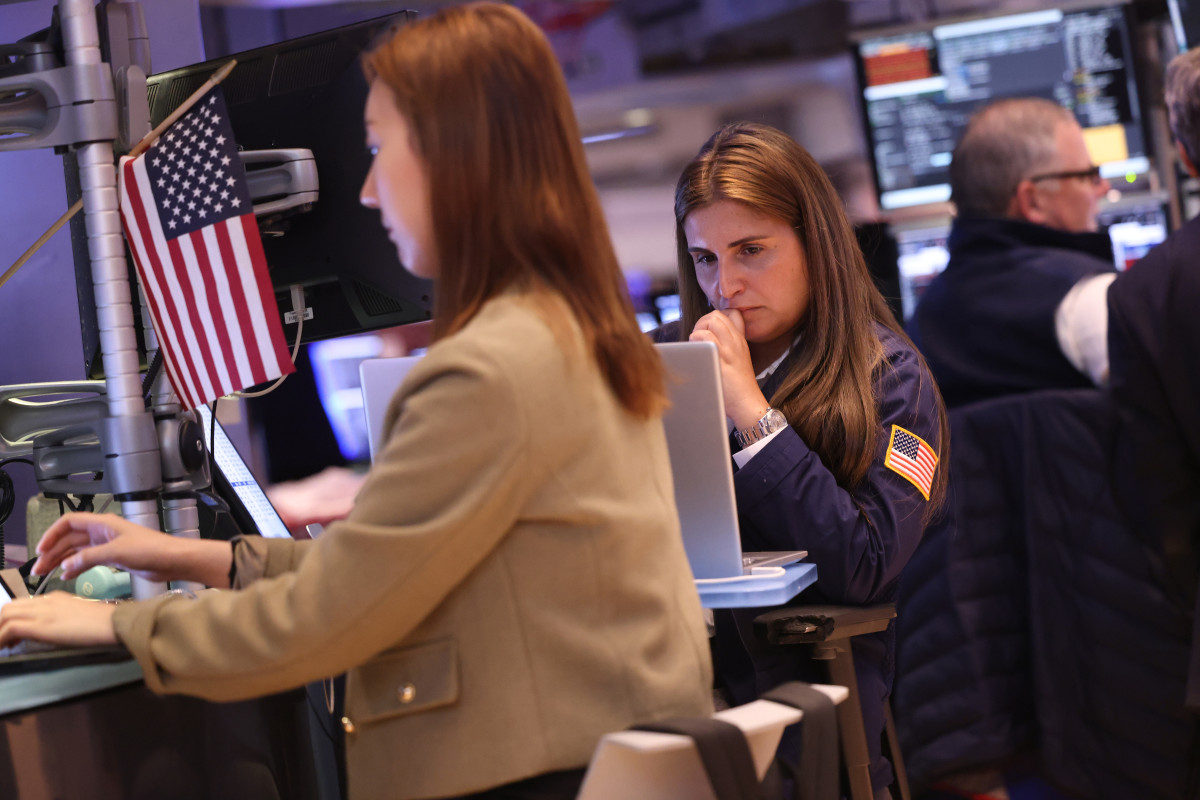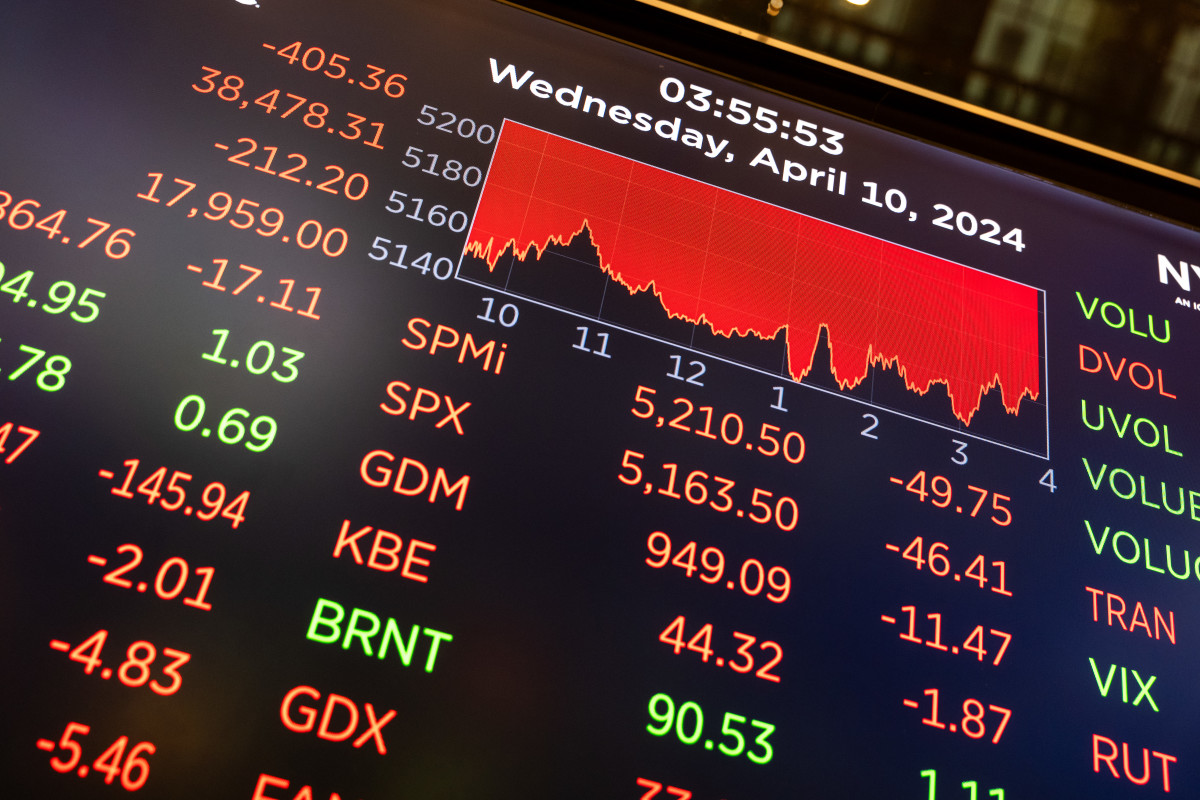
February ended with stocks hitting new highs and not many signs of trouble.
Yes, oil and gasoline prices were higher. Yes, there were some hints of rising inflation.
But those issues seemed to be blips. The Federal Reserve was going to cut interest rates sometime this year as inflation neared 2% a year.
Related: Fed members' updated interest rate outlooks rock markets
Wall Street all but guaranteed multiple ate cuts. Without, dare we say it, paying enough attention to the warning signs.
Stocks slumped in an ugly way on Friday. The Standard & Poor's 500 Index, whose components represent roughly 75% of the market value of U.S. stocks, dropped nearly 1.6% for the week, its second weekly loss in a row.
The Dow Jones industrials fell 2.4% in its second straight weekly loss.
The Nasdaq 100 Index, heavily weighted to favor the biggest tech stocks, fell 0.52% and fell for a third straight week.
And the Russell 2000 Index, which has large concentrations of regional banks and companies struggling to be profitable, fell 3.2%.
In theory, markets might continue to slide, perhaps for a month or so, until rates do move lower (or the Fed acts) and stock prices of strong companies hit levels that make them irresistible.
There have been signs markets were vulnerable
These were increasing warning signs that markets would be pressured, at the very least, before the end of the week.
Oil prices. West Texas Intermediate, the benchmark U.S., was rising more quickly than many expected. Brent crude, the global benchmark, finished at $90.45, up 33% since the end of 2023. Many economists suggest Brent will breach $100 a barrel in the not-too-distant future.
Interest rates. The 10-year Treasury yield closed at 4.532% on Friday, up 16.8% from its 2023 close of 3.881%. Mortgage rates are at about 7.3%, about where they were in late November, according to Mortgage News Daily.
Tech stocks stopped soaring. Nvidia (NVDA) may be up 78% for the year and 121% since the October market bottom. But the shares are down 9.5% since peaking on March 8. The Nasdaq 100 Index last set a 52-week high on March 21.
Tax selling. Some investors may have been selling to settle up with the Internal Revenue Service.
A market that was too enthusiastic?
It may be fair to say that investors' enthusiasm had gotten way ahead of itself.
That was especially true of Wall Street banks and money managers. Many had begun 2024 believing the Fed would cut rates perhaps as much as seven times this year because the economy would slump without rate cuts.
That meant stocks and proxies like cryptocurrencies would surge without end. Bitcoin was at about $68,800 on Saturday afternoon, up 50% on the year. But it has fallen more than 13% from peaks reached in mid-March.
More on the economy and inflation
- Watch out for 8% mortgage rates
- Ex-Treasury official unveils startling interest rate outlook
- Weekly Roundup: Market Sobers Up on Inflation
So far, the Fed has left its base rate, the federal funds rate, at 5.25% to 5.5% since July 2023. Multiple Fed officials wanted more progress in the fight against inflation.
Domestic inflation had hit 9% in summer 2022 and came down as interest rates moved from near 0% in late 2021 to current levels.
The federal funds rate is the rate banks are supposed to charge each other for loans to meet regulatory requirements. All U.S. interest rates start from that point.

What comes next
So, it's possible markets will be volatile next week regardless of what the earnings reports say. JP Morgan Chase's results on April 12 were actually quite strong.
It was the banking giant's cloudy outlook that pushed the Dow component down 6.5%, setting off the big market slump.
It was also fear rate cuts might not happen, plus worries about violence in the Middle East, that pushed the major averages sharply lower on April 10.
It is possible more declines are ahead, but they may be short-lived because 2024 is not 2008.
Downturns of 10% have occurred at least 10 times since 2012, according to Charles Schwab data.
The S&P 500 fell 15% in December 2018 because of former President Donald Trump's threats to start a trade war with China. The market had recovered by the end of February.
When the turn comes this time, it will surprise everyone except the smart people who were looking for it.
A postcard of the October 2023 market bottom
You can see the bottom forming in October 2023 in Nvidia's price action.
The shares had been flirting with $500 through the summer, then started to sag.
On Oct. 26, the shares dropped to as low as $398.80, then bounced back to $403.21.
Confirmation of the bottom came on Oct. 31, when Nvidia hit $392.30, then recovered back to $407.74.
From there it surged to $974 on March 8 and fell back to $875.28. It's been going sideways ever since.
The week ahead suddenly becomes important
So, stocks and markets are pulling back but maybe not dangerously.
A new stress for markets erupted, however, over the weekend when Iran launched a barrage of drones and missiles at Israel in apparent retaliation after an Israeli attack on what Iran said was a consular building within its embassy compound in Damascus.
But evidence on Sunday suggested the missiles caused little damage. Futures trading Sunday suggested stocks would open higher at Monday's open. Oil prices were flat-to-lower.
Related: This is how crazy Buffalo got during the eclipse
Early reports said the missiles, seen over Israel and Jordan were being intercepted. How the attacks affect markets will depend on how much damage and loss of life results.
In the meantime, the week ahead will feature some important economic reports, including:
- Housing starts and building permits on Tuesday morning. Both will likely show housing activity is sliding back because of high mortgage rates.
- Jobless claims, due Thursday morning, a weekly survey of how many people are filing for unemployment compensation.
- Existing-home sales from the National Association of Realtors, due Thursday. The estimate is that sales in March ran at an annualized rate of 4.2 million homes and condos, down from 4.38 million units in February.
Earnings reports ramp up
The first-quarter earnings season began Friday in earnest when some of the biggest banks reported results. The results were mostly good. The commentary, especially from banking giant JP Morgan Chase (JPM) , was less optimistic and helped set off Friday's slump.
The earnings reports will continue over the next months. This week includes reports from:
Monday: Investment banking giant Goldman Sachs (GS) , Charles Schwab (SCHW) , and M&T Bank (MTB) . The trio are expected to report results smaller than in the 2023 first quarter.
Tuesday: Health-insurance giant UnitedHealth Group (UNH) , Johnson & Johnson (JNJ) , Bank of America (BAC) , Mastercard (MA) and United Airlines (UAL) . Investors may see better year-over-year results for UnitedHealth and flat or slightly lower results for the others.
Wednesday: Chip-equipment maker ASML Holding (ASML) ; Abbott Labs (ABT) ; warehousing developer Prologis (PLD) and railroad giant (CSX) . Earnings are expected to be flat.
Thursday: Taiwan Semiconductor (TSM) , Netflix (NFLX) , money manager Blackstone (BX,) and homebuilder D.R. Horton (DHI) . Netflix and D.R. Horton are seen showing the best results. D.R. Horton is one of the biggest homebuilders, with the financial might to make home sales happen even in the current rate environment.
Friday: Consumer products giant Procter & Gamble (PG) and credit-card company American Express (AXP) .
Related: Veteran fund manager picks favorite stocks for 2024







